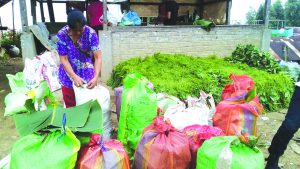Published on Dec 20, 2016
By EMN
Share
 A woman of Longsa village readying vegetables for sale in the market.[/caption]
Wokha, Dec. 19: When the literal translation of the name of the village is embedded/covered by stones, then it is of little or no surprise that Longsa village in Wokha district is famous for stone excavation activities at the numerous quarries in and around the village.
But the story of Longsa village is more than just extraction of stone. The people of the village, quite remarkably, are also known for producing organic vegetables out of their bed of stones which they supply to markets at Kohima and Dimapur.
This village, with roughly 400 households, has been growing and selling vegetable for more than 25 years now. They have learnt to make money not only out of hewing the stones but also from growing greens out of the stones.
The scale of vegetable cultivation by the villagers range from the backyard garden variety to large expanse of cultivated land. Out of this cultivation, they seek to meet the market demands – especially at Kohima and Dimapur.
The organic produce ranges from roots to stems to leaves and fruits. Some of the common ones include yam, chayote and chayote leaves, green chilli, currant tomato, ginger with leaves and flowers, bamboo shoot, cucumber, maize, pumpkin, collard, sweet potato, yard-long beans, chive, toon-leaves, bitter ball, winged beans, passion fruit and leaves, brinjal (eggplant), bottle gourd and bitter gourd.
Interacting with one of the villagers, she said: “Yes, indeed we are helping ourselves (by selling the produce) and also the people who buys and consumes it”.
There are as many as 8 pickup points at Longsa village from where “the collectors” buy the vegetables from the villagers every day (except on Sundays). Then “the collectors” hire vehicles among themselves to transport the vegetables to Kohima and Dimapur.
The collection begins at around 1 pm and it goes on till 5 pm. After all arrangements are made, the vehicles carrying vegetables head to Kohima and Dimapur late in the night.
On Mondays, Wednesdays and Fridays, 3-4 pick-up trucks loaded with the vegetables and fruits rush down to Dimapur while 2-3 Tata Sumos go to Kohima, according to the villagers. On the alternate days – Tuesday, Thursday and Saturday – the number of transport vehicles fluctuates between 1 and 2.
The reason they transport their vegetables late at night, according to the villagers, was to avoid “difficulties” at check-gates. So because of the fear of “facing unavoidable circumstances” at the check-gates, they run the goods at night even though that would mean ‘staying inside the vehicles’ at wee hours until the retailers turn up in the morning.
A woman of Longsa village readying vegetables for sale in the market.[/caption]
Wokha, Dec. 19: When the literal translation of the name of the village is embedded/covered by stones, then it is of little or no surprise that Longsa village in Wokha district is famous for stone excavation activities at the numerous quarries in and around the village.
But the story of Longsa village is more than just extraction of stone. The people of the village, quite remarkably, are also known for producing organic vegetables out of their bed of stones which they supply to markets at Kohima and Dimapur.
This village, with roughly 400 households, has been growing and selling vegetable for more than 25 years now. They have learnt to make money not only out of hewing the stones but also from growing greens out of the stones.
The scale of vegetable cultivation by the villagers range from the backyard garden variety to large expanse of cultivated land. Out of this cultivation, they seek to meet the market demands – especially at Kohima and Dimapur.
The organic produce ranges from roots to stems to leaves and fruits. Some of the common ones include yam, chayote and chayote leaves, green chilli, currant tomato, ginger with leaves and flowers, bamboo shoot, cucumber, maize, pumpkin, collard, sweet potato, yard-long beans, chive, toon-leaves, bitter ball, winged beans, passion fruit and leaves, brinjal (eggplant), bottle gourd and bitter gourd.
Interacting with one of the villagers, she said: “Yes, indeed we are helping ourselves (by selling the produce) and also the people who buys and consumes it”.
There are as many as 8 pickup points at Longsa village from where “the collectors” buy the vegetables from the villagers every day (except on Sundays). Then “the collectors” hire vehicles among themselves to transport the vegetables to Kohima and Dimapur.
The collection begins at around 1 pm and it goes on till 5 pm. After all arrangements are made, the vehicles carrying vegetables head to Kohima and Dimapur late in the night.
On Mondays, Wednesdays and Fridays, 3-4 pick-up trucks loaded with the vegetables and fruits rush down to Dimapur while 2-3 Tata Sumos go to Kohima, according to the villagers. On the alternate days – Tuesday, Thursday and Saturday – the number of transport vehicles fluctuates between 1 and 2.
The reason they transport their vegetables late at night, according to the villagers, was to avoid “difficulties” at check-gates. So because of the fear of “facing unavoidable circumstances” at the check-gates, they run the goods at night even though that would mean ‘staying inside the vehicles’ at wee hours until the retailers turn up in the morning.